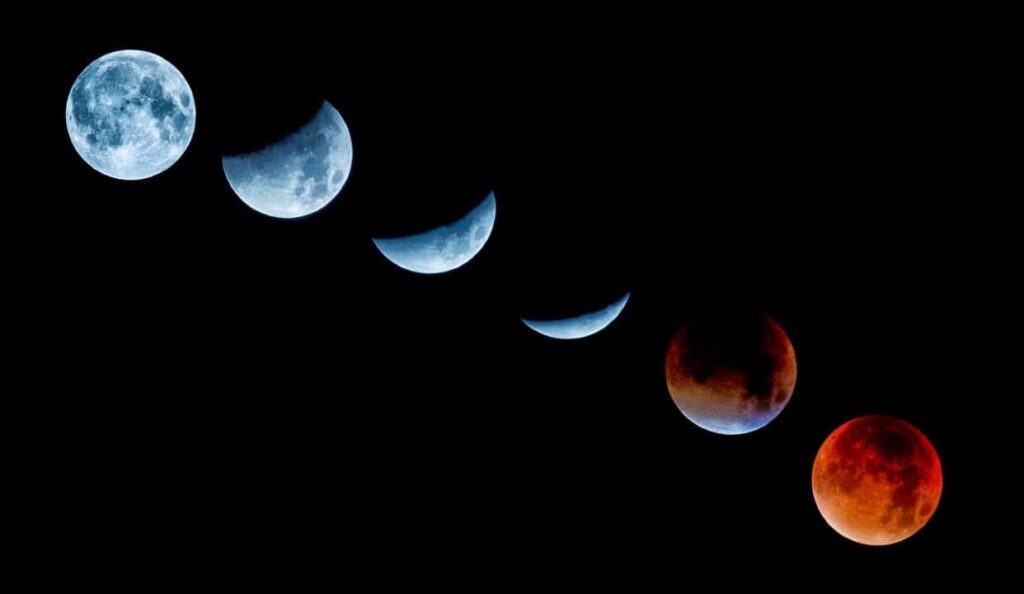
The skies of September 2025 will host rare astronomical events, featuring a total lunar eclipse, a partial solar eclipse, and a Black Moon, when two New Moons occur in the same month. These phenomena, visible across various regions, will captivate astronomers and cosmic enthusiasts. According to the National Institute of Meteorology (Inmet), the lunar phases this month, including Full Moon, Waning Moon, and Crescent Moon, offer unique opportunities for observation and cultural reflection. The events will unfold between September 7 and 29, with the lunar eclipse on the 7th visible nationwide and the solar eclipse on the 21st most prominent in southern and southeastern areas. These phenomena, beyond their visual beauty, influence tides, traditions, and even behaviors, as suggested by studies and cultural practices.
September’s celestial events have fascinated humanity for centuries, blending science, culture, and spirituality. The Moon, with its roughly 29.5-day cycle, shapes everything from tides to rituals in various communities. This month stands out for its rare combination of astronomical phenomena.
The lunar calendar of September offers a continuous spectacle, with each phase carrying unique meanings for observers and cultures. Below, we detail the main events, their implications, and how to make the most of these celestial opportunities.
September 2025 will be unforgettable for skywatchers. The total lunar eclipse on September 7 occurs when Earth aligns between the Moon and the Sun, casting a shadow that fully covers the satellite. The event, from 6:30 PM to 7:52 PM (Brasília time), will be visible nationwide without special equipment. The partial solar eclipse on September 21 aligns with the New Moon and requires precautions like protective eyewear for safe viewing. The Black Moon, with two New Moons on September 1 and 21, is another highlight, symbolizing renewal in many traditions.
These events draw both professional and amateur astronomers eager to capture and study celestial alignments. Visibility depends on weather conditions, but Inmet forecasts clear skies in many areas, particularly in southern, southeastern, and central-western regions.
September’s lunar phases follow a defined cycle, influencing natural phenomena and cultural practices. The Full Moon on September 7, coinciding with the lunar eclipse, triggers syzygy tides with greater amplitude due to the Moon, Earth, and Sun alignment. The Waning Moon on September 14 is seen as a time for introspection, while the Crescent Moon on September 29 symbolizes growth and new projects.
The New Moon, particularly the second one, reinforces themes of renewal. In rural communities, these phases guide activities like planting and pruning, rooted in traditions linking lunar cycles to agricultural productivity. The Moon’s influence extends beyond folklore, with studies noting increased marine animal activity during the Full Moon.
To fully enjoy September’s events, location is key. Rural areas or places with low light pollution, such as remote beaches or countryside fields, are ideal for viewing the lunar eclipse. Binoculars or telescopes can reveal lunar surface details like craters and maria. For the solar eclipse, certified solar filter glasses are essential to prevent permanent eye damage.
Apps like Stellarium and SkySafari aid in tracking lunar phases and optimal viewing times. Photographing events, especially the lunar eclipse, is a great way to capture the moment. Cameras with tripods and long-exposure settings yield the best lunar images.
Lunar phases carry meanings beyond science. In astrology, the Full Moon in Pisces on September 7 is tied to intuition and emotions, while the New Moon in Virgo on September 21 supports organization and planning. Rural traditions link lunar cycles to practical tasks, like cutting hair during the Crescent Moon to promote growth or pruning during the Waning Moon to prevent pests.
Scientifically, the Moon’s gravitational pull drives tides, with greater impact during New and Full Moons. Research also explores effects on animal behavior, such as heightened fish activity during Full Moons, though links to human sleep remain inconclusive.
The Moon has inspired myths, legends, and scientific advances for millennia. Its elliptical orbit causes its distance from Earth to vary between 356,500 km (perigee) and 406,700 km (apogee), affecting its appearance. In the Southern Hemisphere, the Crescent Moon’s illuminated side appears on the left, unlike the Northern Hemisphere, reflecting geographic perspective.
The Moon lacks its own light, reflecting sunlight, which explains its changing visibility across phases. In many cultures, it symbolizes fertility and renewal, shaping agricultural and spiritual rituals. Communities still use lunar calendars for practical decisions, like planting specific crops.
As Eliminatórias para a Copa do Mundo de 2026, que será realizada nos Estados Unidos,…
Milhões de brasileiros enfrentam a necessidade de atualizar a Carteira Nacional de Habilitação (CNH) ao…
A renovação ou emissão da Carteira Nacional de Habilitação para motoristas profissionais em 12 de…
Em Porto Alegre, neste sábado 13 de setembro de 2025, às 16h, o Grêmio enfrenta…
Em uma reviravolta que agita os corredores da Televisão Carioca Associada, Marco Aurélio, vivido por…
Nintendo’s historic September 2025 Direct, a one-hour livestream held on Friday, September 12, from its…